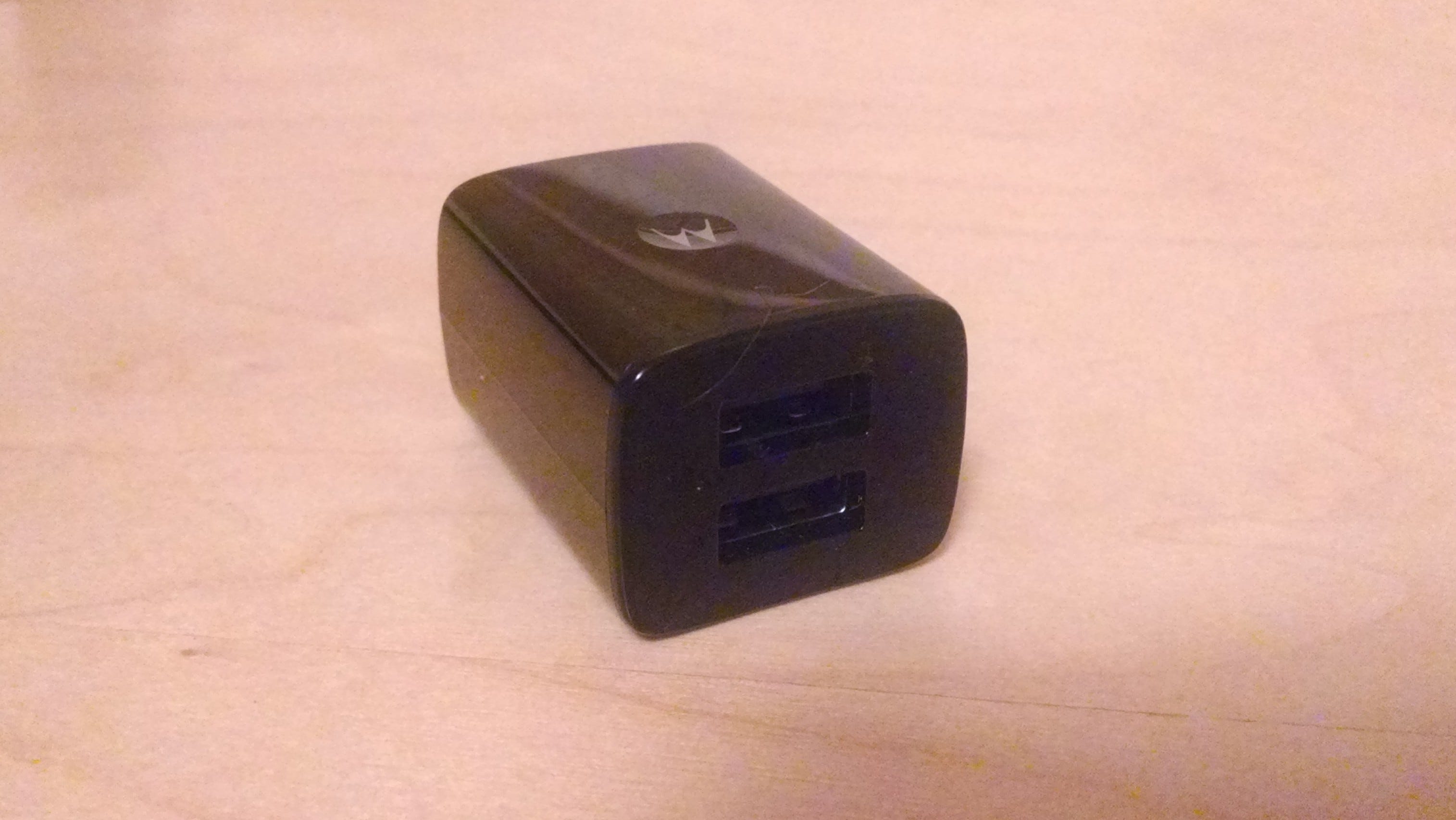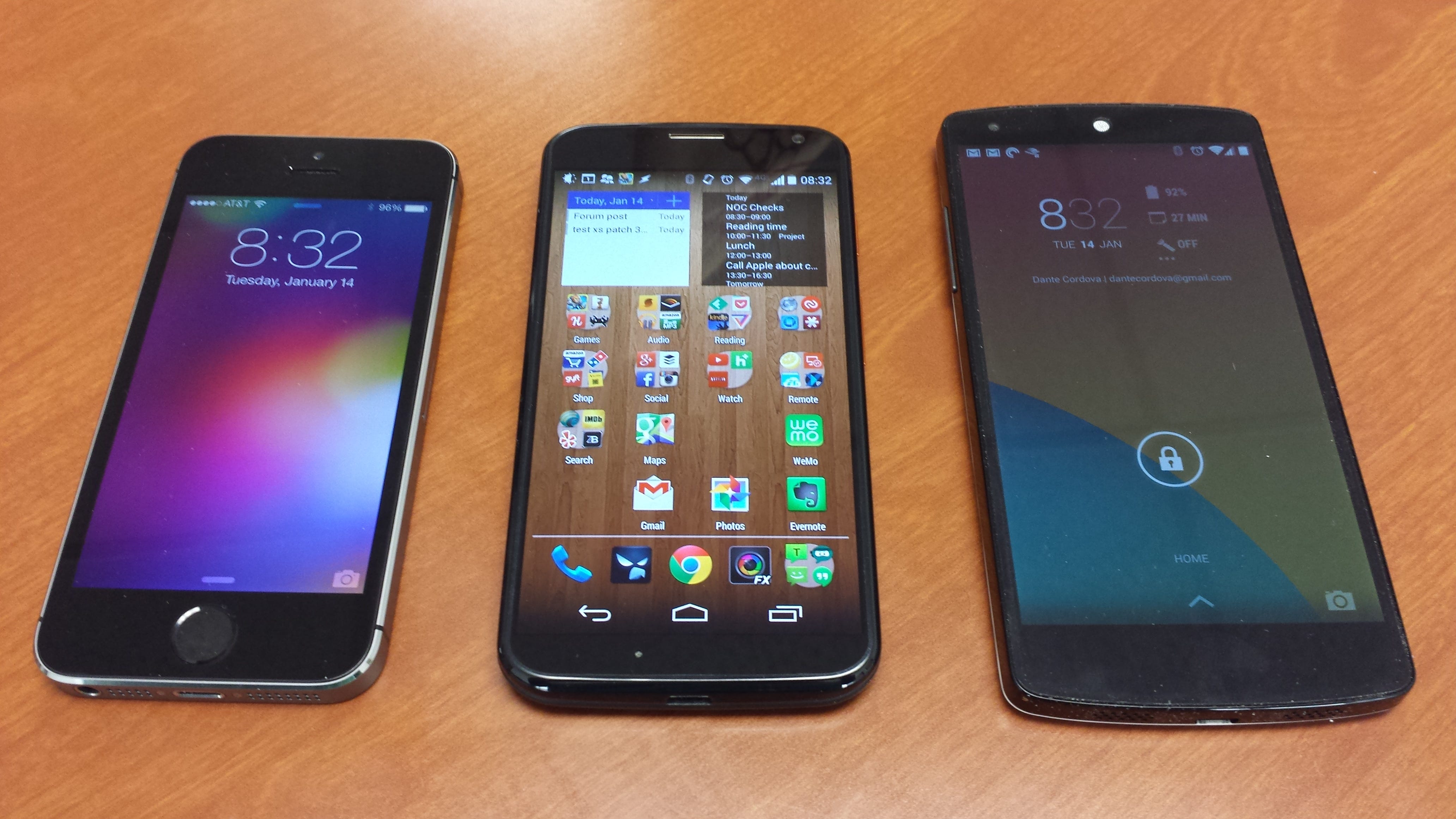Nexus 5 or Moto X? Review and Comparisons from a Past iPhone User
Posted on January 15, 2014 • 13 minutes • 2663 words
TL;DR — I was using an iPhone 4s for two years, an iPhone 5c for a few months, I really liked how fast and small they both were. I bought a Nexus 5, used it for a couple weeks, but didn’t like the size and poor camera performance. I bought a Motorola Moto X. It’s not as good as an iPhone, but it’s the best Android phone I could find.
First here is just a little bit of background about my phone priorities because my priorities are probably not yours.
- The phone must have a good camera. And by good I mean being able to take pictures of constantly moving objects (kids) in low light (indoors).
- The phone battery has to last at least 1 day without charging. At work I am not always at my desk and need something that I can use throughout the day without being unreachable by the end.
- It needs to be a reasonable size. None of this Galaxy Note crap. I like smaller phones. If someone updated the specs on the HP Veer and it ran Android, I’d probably use that.
- Usable in 2 years. I would like OS updates for at least 18 months and the phone should not feel like it’s falling apart and too slow to run apps in 24 months.
- The phone must integrate with Google services, or have good compatible apps. This rules out Windows Phone for me.
- Wireless charging is a huge plus. I find it convenient and love the option.
And just to be thorough, here are a few things I really don’t care about in a phone
- Unlocking bootloaders and custom ROMs, I don’t have the time to search for and flash my phone repeatedly. Any customization I am going to make needs to be small and easy. I’m too busy to do that anymore.
- NFC, I won’t use it, I don’t care.
With all that said, I’ve had a lot of smartphones in the past. In 2011, after webOS’ demise, I settled on the iPhone 4s as a good smartphone for my needs. It was small, fast (for its time), and had the best cell phone camera on the market. Even after two years of using it and iOS 7 update I didn’t feel the need to buy a new phone immediately. It still fulfilled my needs with Google’s apps loaded on the phone and jailbreak tweaks that let me set default apps. I bought and used a 5c for a few months and really enjoyed the slightly larger screen, better camera, and insane battery life. Under normal usage the phone lasted a full 48 hours before it was dead.
Nexus 5 Review
I bought the Nexus 5 within minutes of it being announced which is very unusual for me. I didn’t read a single review (there were none) but felt the $350 off contract price was a reasonable risk for me to take. If I didn’t like the phone I would sell it for full price or maybe lose $20–40 which was acceptable. Because I got the phone only a week after it came out that also means I was on Android 4.4 without any updates. Keep that in mind with this review because some of my complaints have been fixed via updates.
The Nexus 5 had everything I was looking for on paper. I knew the screen would be a little big but I was hoping the phone felt smaller in the hand like the Moto X did. The Nexus 5 didn’t. I had multiple issues with activating the phone but that was mostly an Android problem and not the Nexus 5. After activating I had problems with apps not installing until I rebooted the phone each time and various other weird issues but as far as I know, they were all problems with Android 4.4 and not the Nexus 5. I didn’t hear of a single other person having these problems.
The hardware looks great. The black one is completely black soft touch without any faux textures or needless embellishments that drive me crazy on phones. The edges have a slight taper which felt really good when holding the phone. The soft touch was also extra grippy, similar to the old IBM Thinkpads which was great. If you bought the white one, I’m sorry, it looks pretty bad and it’s glossy plastic.
The screen was stunning, it almost looked fake. Not only is it 1080p but the IPS LCD made the image look hyper realistic. The touch screen was so responsive it removed some of the feeling of interacting with a phone. The screen was too big to comfortably use with one hand so I always resorted to using two. It wasn’t terrible but got annoying coming from an iPhone 5c. The screen looked great while reading documents and watching videos but the traditional LCD backlight got a bit annoying when trying to use the phone at night. I typically like to read light text on a dark background, but that really only works well for OLED screens which don’t have traditional CCFL backlights. I had the same complaint with the iPhone but because the Nexus 5 had an inch bigger screen it felt like looking into a flashlight while trying to read.
The power and volume buttons had a good feel and placement on the phone and the speakers were louder than the iPhone. The earphone hole was really small though. I often found that I missed it when holding the phone to my ear and had to slide the phone to the right spot to be able to hear a call.
The micro USB on the bottom was “upside down” which was annoying and the camera lens protruded slightly from the back which made me always a little nervous I would crack it. The official cases fix the lens problem by adding some extra thickness to the back. I really like the colors of the cases but dislike cases enough that it wasn’t something I considered.
The battery wouldn’t last quite a full day. I consistently take my phone off the charger at 0600 and return home from work at 1800. By that time the phone would have about 10% battery under normal usage. I never trusted that because if I had a day of heavy usage I’m sure it would not have lasted through the work day.
The camera was, for my uses, unusable. Everything was a blurry mess. The shutter was so delayed there was no chance I was ever going to get a decent picture of a moving target. Here are just two samples to show you what I’m talking about.

This was the best of three pictures I took. And it still does not look very good with over exposed light and blurry cars.
I haven’t used the Nexus 5 since the 4.4.1 update came out and fixed some of the camera problems, but it was such a bad first impression that I gave up.
Just to wrap up the Nexus 5 review
Pros
- Great screen
- Good Soft touch texture
- Really fast
Cons
- Crap camera
- Poor battery life
- Too big
Moto X Review
I toyed with the idea of getting a Moto X before getting the Nexus 5 but the lackluster camera tests I saw made me hold off and if I were going to get one I really wanted it with a wood back. They also seemed too expensive initially at $200 on contract. After realizing I wasn’t happy with the Nexus 5 though I was able to get a promo code through Motorola’s black Friday sale which made a customized Moto X $350 off contract (same as the Nexus 5). I sold the Nexus 5 and got the Moto X even though the wood backs were not yet available. I got it because I found out you could get a soft touch back instead of the hard plastic that the in store Moto X came with from the carrier. I’ll admit The Verge staff also convinced me a little bit after hearing a lot of the editors on the Vergecast and Mobile Vergecast say they use the Moto X.
Setting up the device wasn’t nearly as painful as the Nexus 5 because the Moto X used a micro SIM card which I already had in my iPhone. I switched the SIM and logged into my Google account as usual and then it started syncing apps and accounts. The problem was the phone was REALLY slow while syncing. So slow that I just set the phone down and let it sit for about an hour. I didn’t have that problem with the Nexus 5 nor with either iPhones.
The Moto Maker option with soft-touch backs are pretty limited in color options so I ended up with an all black phone with orange accents. Disappointing, considering the cool yellows, reds, and blues they have but I also like the murdered look which is probably why I like how the Nexus 5 looks so much. The soft-touch isn’t as grippy as the Nexus 5 but was good enough to feel like a more solid device in my hand. The Motorola logo on the back has a slight dimple and for some reason I really like it. The phone is smaller than the Nexus 5 with a screen of 4.7″ and with the curved back feels really nice in the hand. The front half of the phone doesn’t have the soft-touch grip to it which looks a little odd but it’s not the worst thing in the world. The Moto X is closer to the iPhone 5 size than it is to the Nexus 5.
The power and volume buttons are both on the right side (poor lefties) which I’m not a fan of because it makes the volume rocker pretty small and hard to activate sometimes. There isn’t enough leverage to make sure I’m hitting the right button when it’s in my pocket. The power button also seems to be mounted a bit low for a “smaller” phone. The speaker is mounted on the back of the phone which, thanks to the curved back, works great when sitting on a table. But if you try to watch a video or listen to audio you’ll end up cupping your hand and not be able to hear anything still. Everything else, hardware wise, is fine and the micro USB port is even installed the way I like (not upside down).
The battery will last, just barely, a full day for me. At the end of the work day I usually have about 40% battery left (0600 until 1800) and I often can last until midnight with 5–10% left. It’s a big downgrade from the iPhone but enough I can live with. I wish the Moto X had wireless charging built in which would help getting through a day, but because it charges with micro USB I just make sure to charge it at lunch to make sure it will last.
I have never had a phone with an AMOLED display before, and although I’ve used them in the past on friends phones I never realized how nice it is for night reading and clock displays. I haven’t had any problems seeing it in the sunlight, which is a typical complaint of AMOLED, but I find myself manually adjusting the brightness more than I would on the iPhone. I think that’s an Android problem because I have done that on all my previous Android phones too.
The camera was my biggest worry with the Moto X. I had gone to the store prior to buying the phone and tested the camera just to see how Motorola’s customized software worked. I like the rapid picture mode, although it doesn’t work as well as the iPhone 5c, but I’m not sold on the tap anywhere to take a picture aspect. Overall the camera takes faster and better pictures outside than the Nexus 5 did and it doesn’t have the same shutter lag. The pictures inside are inconsistent with their color accuracy and macro shots are near impossible. Video works well and I like that it includes a slow motion video option. One thing I didn’t think I’d use was the camera gesture (two wrist flicks) but it works 80% of the time with is enough for me to try it first before using the lock screen shortcut. It gives a quick vibrate feedback and then opens the camera.


This shot took me about 10 tries before the charger was in focus and not yellow tinted from my lights
An outdoor shot that any camera should be able to take but it still turned out nice.
The rest of the Motorola add-on software is nice but sometimes a bit buggy. Here’s just some quick pointers on what they added.
- Active Notifications — Everybody loves this but I don’t find it as easy or functional as the iPhone lock screen notifications. It works alright but it’s sometimes weird to have a notification screen before your lock screen. It also sucks that you can only see info from the most recent notification.
- Assist — It does a really good job of figuring out your driving and reading you messages. The meetings mode is annoying though because it won’t see if I’m set to busy or free during the meeting. I often schedule things on my calendar that I’m willing to be interrupted for but it doesn’t take that into account.
- Trusted devices — This is probably my favorite feature by simply disabling your lock screen when connected to a bluetooth device you specify in the settings. I have it set for my car stereo and am debating getting a BT headset or smartwatch just to use this more often. It was much easier than tasker and was built into the phone.
- Motorola Help — This is a chat portal for Motorola’s support. It works really well and even gives info about your phone (SN, IMEI, etc.). I chatted with them about a problem I was having and was able to get it resolved in about 10 minutes. It doesn’t notify the support person that you’re chatting from your phone though because they recommended I reboot my phone which I wouldn’t be able to do while chatting.
- Motorola Connect — This is a way under reviewed feature which allows you to send SMS from Chrome on your computer. It also shows call logs and battery status. It has completely replaced the Google Voice plugin for me and works a lot better.
- Touchless control — allows you to say “OK Google Now” at any time to get a voice prompt. It works maybe 60% of the time and it’s annoying that it keeps jumping back and forth between Google Now and it’s interface. All the app switching makes it really slow too so I typically don’t use it. Although it is more useful than the Nexus 5s “OK Google” to search, it is no where near as good as Siri for speed, voice recognition, and functionality.
To sum it all up
Pros
- Smaller size
- Good battery life
- Add-on software that is actually useful
Cons
- Slow performance
- Bad speaker placement
- Camera not great
- Wood backs cost $100 extra
Overall I’m happy with the Moto X over the Nexus 5 but I have a feeling that in a year I will want something else. The phone will probably be too slow and because the battery will probably only last 1/2 a day. If I really wanted something I know I would be happy with in two years I probably should have stayed with an iPhone. I think most of my complaints with the Moto X are Android related and not actually problems with the Moto X hardware. Now it’s just a waiting game to see how long the Moto X will receive Android updates.
Originally published at 1n73r.net on January 15, 2014.
